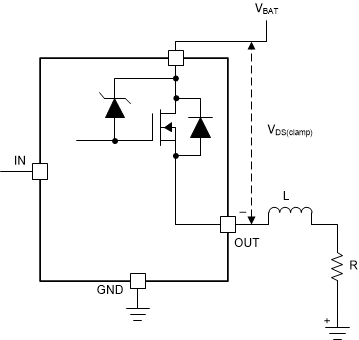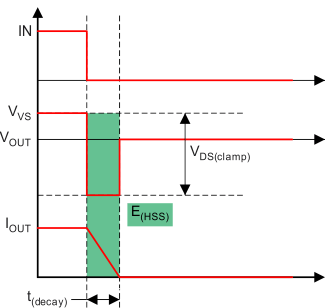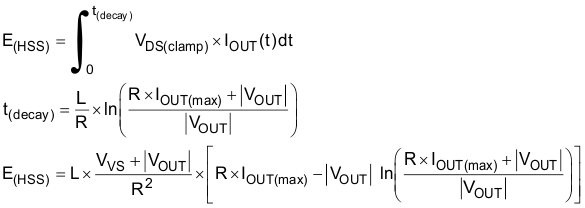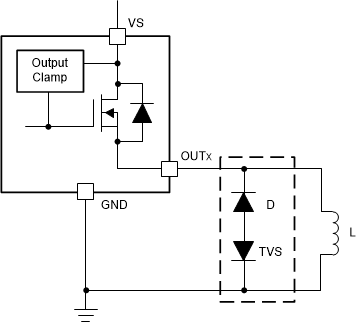ZHCSET0D December 2015 – December 2019 TPS2H000-Q1
PRODUCTION DATA.
- 1 特性
- 2 应用
- 3 说明
- 4 修订历史记录
- 5 Device Comparison Table
- 6 Pin Configuration and Functions
- 7 Specifications
-
8 Detailed Description
- 8.1 Overview
- 8.2 Functional Block Diagram
- 8.3 Feature Description
- 8.4 Device Functional Modes
- 9 Application and Implementation
- 10Power Supply Recommendations
- 11Layout
- 12器件和文档支持
- 13机械、封装和可订购信息
8.3.4 Inductive-Load Switching-Off Clamp
When switching an inductive load off, the inductive reactance tends to pull the output voltage negative. Excessive negative voltage could cause the power FET to break down. To protect the power FET, an internal clamp between drain and source is implemented, namely VDS(clamp).

During the period of demagnetization (tdecay), the power FET is turned on for inductance-energy dissipation. The total energy is dissipated in the high-side switch. Total energy includes the energy of the power supply (E(VS)) and the energy of the load (E(load)). If resistance is in series with inductance, some of the load energy is dissipated on the resistance.

When an inductive load switches off, E(HSS) causes high thermal stressing on the device.. The upper limit of the power dissipation depends on the device intrinsic capacity, ambient temperature, and board dissipation condition.
 Figure 29. Drain-to-Source Clamping Structure
Figure 29. Drain-to-Source Clamping Structure  Figure 30. Inductive Load Switching-Off Diagram
Figure 30. Inductive Load Switching-Off Diagram From the perspective of the high-side switch, E(HSS) equals the integration value during the demagnetization period.

When R approximately equals 0, E(HSD) can be given simply as:

Note that for PWM-controlled inductive loads, it is recommended to add the external free-wheeling circuitry shown in Figure 31 to protect the device from repetitive power stressing. TVS is used to achieve the fast decay. See Figure 31 for more details.
 Figure 31. Protection With External Circuitry
Figure 31. Protection With External Circuitry